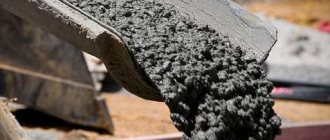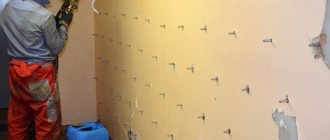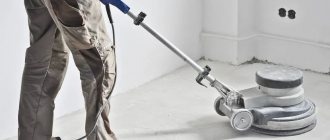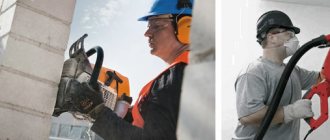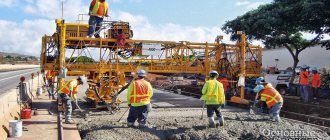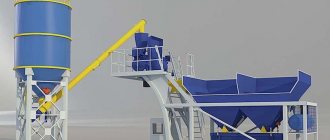As a result of soil subsidence, various types of chemical reactions, sudden changes in ambient temperature levels in poorly executed brickwork or monolithic concrete, the structure shifts.
As a result, various types of defects arise, which, in particular, can include cracks, cold seams, and voids. If the growth of cracks, both in length and width, has stopped, then they can be patched using a special injection construction pump.
Injection pump DESOI LE-303
If this is not done in time, then in the future the above defects may lead to the collapse of the entire structure. After correctly performing the injection procedure for buildings and structures, all structural and physical characteristics of both brickwork and monolithic concrete will be completely restored.
Water often gets into poorly sealed seams or cracks, which leads to very rapid destruction of buildings and structures. Measures to eliminate such defects can be very different. Cracks and seams can be repaired using a spatula, mastic, a trowel, or any other available means. However, such measures can only mask the problem, but not eliminate it. For high-quality and reliable sealing of cracks in buildings and structures, we recommend using an injection pump of the currently popular brand ksg 900.
The injection pump allows you to quickly, and most importantly - efficiently, perform various types of waterproofing work of any degree of complexity, as well as absolutely any volume. Injection pumps are used mainly for pumping cement mortar and, in particular, microcement into hard-to-reach places, thus providing reliable protection of buildings and structures from the destructive effects of moisture. The manual injection pump is made mainly from stainless steel.
1.1 Basic properties
The injection type hand pump has the following properties:
- high level of quality;
- high level of productivity;
- ability to withstand intense loads;
- Possibility of operation even in the most severe temperature conditions.
With the help of this type of construction equipment, the injection of cement compounds, polyurethane, and epoxy compounds can be carried out easily and simply.
1.2 Scope of application of injection pumping equipment
Injection type pumping equipment can be used to perform the following types of work:
Dosing pump device
- liquidation of the consequences of various types of disasters;
- liquidation of consequences of man-made accidents;
- elimination of inflows of varying degrees of intensity;
- elimination of various types of geological complications that arise during the drilling process, as well as during the operation of gas wells;
- elimination of various types of geological complications that arise during the drilling process, as well as during the operation of oil wells;
- elimination of various types of geological complications that arise during the drilling process, as well as during the operation of geological exploration wells;
- carrying out various types of waterproofing work;
- carrying out various types of repair work;
- carrying out various types of construction work;
- filling microcracks.
Installation inclined for injection UVN-3N (analogue of BMP-6)
Can be used as an injection pump for filling cracks in concrete/brick structures, supplying mortar to a height (for example, to the second floor), etc. It is also possible for wet shotcrete (applying plaster solutions directly to walls, etc.).
Advantages: - removable hopper 30 l, - high-pressure screw pump with wear-resistant stator, - adjustable stator and screw feeder, - mobile design, - powered from a 220V household network, - small dimensions and weight, - ability to pump viscous liquids with solid particles up to 3 mm,
Differences between the UVN-3N pump and the BMP-6:
Unlike the German pumps BMP 5 and 6, the materials used are NOT disposable, such as: 1. Steel body versus plastic, which allows our pump to be repairable, and not disposable, like the BMP. 2. Hinges with increased service life in a sealed case - versus standard open male-female forks. 3. Stator made of polyurethane - the most wear-resistant material in the abrasive. Compared to regular rubber, it is 3 to 6 times more wear-resistant! 4. The presence of a crimp clamp, which turns our polyurethane stator into an adjustable one, i.e. As wear occurs (pressure and productivity drop), it is possible to tighten the clamp and continue to work until the first one is completely worn out. 5. The rotor is made of steel 40X13, hardened at 60 units. and having stainless steel properties, unlike the German chrome-plated steel version. 6. Rebir 2kW collector drive, which has a real cost of 15 thousand rubles. always available, against their German Eibenstok 1.8 kW drive. costing from. 1 thousand euros with delivery time from. 3 months 7. Technological hole in the pump drive housing for the product to flow out after possible (over time) oil seal leaks, in order to prevent liquid from entering the bearings of the Rebir drive. 8. A fundamental change in the layout of supports and wheels, which affects the weight distribution when the pump moves on the construction site. Those. The wheels in our pump are in the front, and not in the back like in an infantry fighting vehicle, which is much more convenient.
| Model | Supply, m3/hour (min-max) | Pressure, atm (max) | Exit | Dimensions | Weight, kg | Price, including VAT, RUB | Availability |
| UVN-3N_220V | 0,6-0,9 | 20 | 3/4« | 730x450x1125 | 28,0 | 168500 | Check |
Principle of moisture protection technology
The method of waterproofing structures using injection is a fairly new technology. Its main principle is to pump fast-hardening solutions directly into the places where voids form. It can be used in brick, stone, concrete, reinforced concrete structures of walls, foundations and ceilings. Another advantage of the method is the low price of equipment and consumables.
The waterproofing procedure is quite simple to perform, and therefore does not require a sufficiently high level of training and knowledge. It is only necessary to select the right solutions, carry out internal injections into the depth of the structure or apply the mixture to the surface of the place where cracks form. Waterproofing is carried out by pushing liquid out of voids formed in the structure. After this, the brick or concrete is bonded and the strength of the base increases, and the process of its destruction stops.
Order concrete injection
Injection allows you to quickly eliminate defects, seal and waterproof the surface. Using this method, it is possible to repair concrete structures that are located in the ground, without dismantling and excavation work. Injection can be carried out at any temperature; weather conditions do not affect the hardening of the mixture.
In our work we use modern equipment and materials for injection. We use tubes of different diameters to fill different types of damage. Before starting work, we inspect the damage, select the appropriate technology, equipment for injecting concrete, and materials for pouring the mixture.
The first visit of specialists to the site to inspect the premises and take measurements is free. You can arrange the time of your first visit by calling us or leaving a request for a call back.
Injection method for strengthening concrete: sealing cracks, application and selection of injector
Using the injection method to strengthen concrete is not a new technology, but it has become widely used with the advent of special consumables with better characteristics.
In order to increase the service life of concrete building structures, the latest technologies and materials are used today. The most promising mixtures used in injection include polymer compositions.
In what cases is concrete injection carried out?
- The concrete injection method is used to organize the process of waterproofing basements and tunnels.
- Concrete injection is an excellent way to eliminate cracks in walls, floor screeds and ceilings.
- This method is relevant for foundation restoration work if the “cold seam” technique was used during its construction.
- Injection strengthening of concrete makes it possible to increase the waterproofing capabilities of block foundations.
- Concrete injection is an excellent solution for strengthening piles during foundation repairs.
- The crack injection method is relevant for deformation of joints in the bases of underground parking lots, underground passages, and metro tunnels.
Injecting concrete has a number of advantages
- this type of construction work allows you to maintain the integrity of the structure and not disrupt the design of the building;
- injection allows you to quickly carry out moisture protection and sealing of the necessary parts of the structure;
- This method allows you to restore the most inaccessible areas of buildings and foundations;
- concrete injection technology does not provide for the organization of ground work;
- This concrete strengthening technology can be used year-round.
When strengthening concrete using the injection method, it should be understood that the quality and result of the measures taken are directly dependent on the materials.
Mixtures for strengthening concrete by injection
Special materials for injecting defects in walls and other elements of buildings must meet certain conditions.
Such compositions must have:
- low astringent properties;
- pronounced ability to adhere to a variety of materials, i.e. high adhesion;
- the ability to fill even the smallest cracks, i.e. have good penetrating characteristics;
- corrosion resistance;
- minimal shrinkage properties after hardening;
- long service life.
All these qualities are combined in three main types of materials used for concrete injection:
- epoxy and polyurethane resins,
- polycement materials (microcements),
- specialized waterproofing solutions.
Pros and cons of strengthening with injection technology
Important advantages of this technology are:
- injection makes it possible to process complex building structures and eliminate leaks, avoiding emergency situations;
- the method is completely independent of natural conditions and factors;
- the technology is quite economical: with accurate calculations it allows saving materials and labor costs;
- injection can increase the moisture-repellent and load-bearing properties of buildings and structures;
- the method helps to increase the service life of compounds that are pumped into void spaces of buildings and structures;
- high efficiency indicators, which have been tested in practice;
- no flaws.
The disadvantages (features) of injection technology include: the high cost of the materials used and payment for the services of a professional team of craftsmen.
The method of strengthening concrete by injection is resorted to after a thorough visual inspection of the concrete elements and discussion of other possible repair work.
Process of filling cracks in concrete
If the crack depth is up to 0.5 mm, then this technology is the most acceptable and affordable option to eliminate defects. Before injecting cracks, the condition of the metal elements of the reinforced concrete structure is studied.
If traces of corrosion are found, manual injectors are used. This will allow you to quickly fill all cavities in concrete with minimal material costs. If during the inspection corrosion damage or parts of the concrete slab with delamination elements were discovered, then the damaged parts of the structure must be removed.
For these purposes, use a grinding machine or clean the elements manually. Experts recommend that such work be carried out without fail and not neglect the presence of rust and damage in the structure.
This can have quite unfavorable consequences: the injection solution will not harden correctly, which will lead to the expansion of cracks.
Proven algorithms for the restoration of concrete elements:
1. Horizontal method. The cracks are filled with a special solution on each side simultaneously. It is important here that all work is carried out smoothly, from the center to the edges of the structure.
2. Vertical method. Injection of building elements is carried out from the lowest point to the upper end.
3. Ceiling method. The technique of filling voids is carried out using horizontal technology.
The same algorithm is used if epoxy resins are used as the material. The resins have a high level of viscosity and do not leak out of cracks and holes.
When the material with which the voids are filled hardens, the final layer should be applied to better insulate and decorate the structure so that various defects that could indicate repair work are not visible.
Polycement injection materials
If the damage to concrete or brick elements of buildings and structures is more significant, then polycement compositions are used for injection.
This is a Portland cement composition that was specially developed for this type of work. The material has a special degree of grinding, which allows this type of microcement to penetrate perfectly into all cavities and cracks.
In addition, such mixtures may include special microcomponents. For example, the specialized solution “Runit injection for masonry” includes white Portland cement and lime, as well as carbonate-quartz filler and a number of additional additives.
This composition allows you to control the hardening time of the composition, which makes it possible to take breaks during work.
Typically, microcement mixtures are used to strengthen old buildings using reinforced concrete columns. This method is called strengthening the foundation with drilled injection piles. The technology of these works follows a certain algorithm.
First, wells are drilled into which cement is injected under high pressure. Special concrete structures are installed in the wells at an angle of 45°. In addition, this material is widely used in the fight against shrinkage cracks and to eliminate water inflows.
Necessary equipment
To perform the procedure, an injection pump and parker tubes are required to pour the solution into the thickness of the concrete. Professional equipment is quite expensive, so it is more profitable to order concrete injection from a construction company than to carry out this procedure yourself.
Injection pumps
This equipment creates high pressure and supplies repair solution to the tubes. To repair industrial floors, professional pumps with increased weight and large reservoir volumes are used. Compact hand-held models are not suitable for this purpose.
There are different pump models designed to work with different solutions and mixtures.
- Electric diaphragm or piston type pumps are used for pouring epoxy, polyurethane and other resins.
- Piston and pneumatic pumps are used to fill acrylate gels.
- Electric screw-type pumps are used for pouring cement mortar.
Since mortars and mixtures are often two-component, some pump models contain two containers for materials. The components are mixed during operation of the equipment, before the substance is supplied to the tubes.
Parker tubes
The necessary equipment for concrete injection includes parkers. These are tubes that are hollow inside, through which the repair solution enters the thickness of the concrete. Tube models vary in diameter and length, but they all consist of three parts:
- Anchor rubber.
- Hexagonal tube.
- Connection fitting.
The walls of the parkers have high strength and maintain integrity when the working substance is pumped inside under high pressure. The choice of tubes depends on the existing damage. The longer the crack, the more tubes are needed for repair.
Operating rules
- Before starting operation, check the integrity and tightness of joints and connections.
- The maximum permissible pressure must not be exceeded.
- During breaks between work, the injection pumps are turned off using a stop valve and the pressure in the hose is reduced.
- If the hose is damaged, the pressure in the system decreases.
- Sprayers must not be directed at living creatures.
- The operator performs work only in protective clothing.
Installation and preparation for work
Before starting installation, it is necessary to prepare working materials. Substances for spraying are marked with viscosity, temperature and mixing ratios.
- a manual injection pump or an automatic pump is installed on a flat surface;
- substances and materials that will be needed during operation are placed close to the unit;
- using a coupling, the packer is connected to the spray gun;
- check the pressure.
During operation, problems arise that can be corrected independently.
Troubleshooting
- When the device is turned on, the injection does not work. The cause of the problem is a clogged pump or valve, the valve is open. To eliminate this, remove the hose, open the valve, and tap the valve to clean the valve.
- Nothing happens when the handpiece is launched. The cause of the problem is a breakdown or stop of the pneumatic motor, the air vent is closed. If the motor breaks down, you must contact a specialist. When stopping, the screwdriver pushes the studs into the air motor.
- The operating device has no pressure. The reason is freezing of the air motor or low air pressure. To eliminate this, the system is filled with antifreeze, turning the regulator the pressure increases.
- When the tip is deactivated, the pump operates and material is removed. The valve and gasket are worn out. Fix the breakdown by replacing parts.
Injection pumps provide filling of cavities with epoxy or polyurethane substances and mixtures consisting of cement in order to prevent destruction.
Tools
To introduce the selected composition into the stone, special equipment is used - concrete injection pumps, packers, control and locking mechanisms. Pumps create pressure that injects solutions. Resins and microcement require pumps of different capacities. For small repair areas, a manual copy can be used. Packers for concrete injection are tubes that are mounted in holes or on the surface of the object being repaired. Through a system of hoses, a solution is supplied to them under pressure and injected into the defect area. Packers are variable in length, material of manufacture and configuration, and are selected according to the assigned task.
General information
Successful repair of structures begins with an accurate and correct assessment of the condition and determination of the causes of their damage. All subsequent stages of recovery and protection directly depend on the resolution of these issues.
Types of defects and factors influencing their occurrence
The formation of cracks in exploited buildings is a consequence of many reasons. Depending on the predicted danger, such defects are divided into structural and non-structural.
Structural factors affect the strength of a structure and can arise as a result of the following factors:
- design errors;
- construction miscalculations;
- ground movement;
- settlement of foundations.
Non-structural - the most common type of cracks, which in their appearance can be:
- superficial;
- end-to-end;
- internal.
The formation of these defects is influenced by the following points:
- shrinkage;
- internal stresses occurring during cement hydration;
- temperature deformations;
- humidity fluctuations;
- reinforcement corrosion;
- mechanical influences.

